Harvesting ‘true cinnamon’: The story of the Ceylon spice-By Zinara Rathnayake
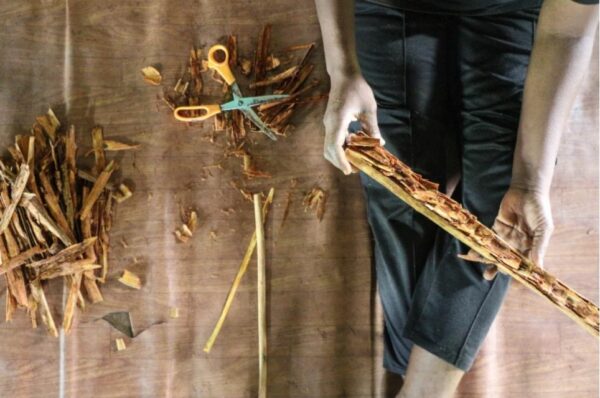
A worker stuffs cinnamon barks with small cuttings of the bark called quillings to make one 42-inch cinnamon quill [Nathan Mahendra/Al Jazeera]
Source:Aljazeera
It is 9am in the Carlton estate in Thihagoda, a small town about 160km (100 miles) south of Sri Lanka’s capital Colombo, and the July sun hides behind inky clouds. The air is thick and hot. Two men walk to the main estate building carrying piles of cinnamon branches. Inside, a group of women sit on the cement floor, chatting as they peel cinnamon.
Since 2000, workers here have planted, harvested and peeled cinnamon, sending batches of the fragrant sticks to a factory in Kamburupitiya, a 15-minute drive away, where they are cut, packed and loaded onto shipping containers for export.
Cinnamon harvesting usually takes place from June to December when the monsoon skies burst into downpours. But here at Rathna Producers Cinnamon Exports, it is produced throughout the year on the 42-acre (17 hectares) estate. “When we are done harvesting one acre, the next acre is ready,” says Chamara Lakshith, 28, the estate’s visiting officer, whose job involves coordinating between the estate and the main office in Kamburupitiya. “But sometimes for a few weeks, the bark is so hard that you can’t peel cinnamon. We know it by looking at the trees; young leaves turn striking red.”
The family business that began in 1985 is run by Ravindu Runage, whose late father started in the cinnamon trade with 7,000 Sri Lankan rupees ($35) to buy cinnamon from small farmers and sell it to bigger traders.

Now, Runage says the company is one of the largest cinnamon producers in Sri Lanka, exporting cinnamon and other spices like nutmeg and black pepper to 56 countries. Apart from growing organic cinnamon, the company also sources it from 8,000 individual and small-scale farmers and exports more than 30 containers of cinnamon a month.
“We grew up with cinnamon,” says 36-year-old Runage, at his office in Kamburupitiya, surrounded by several industry awards his family has won over the years. “We lived in a two-bedroom house. We slept in one room. In the other room, my thaththa [father] stored cinnamon.”
Once they were in the business, the Runage family learned that Mexico is one of the biggest cinnamon consumers. “So thaththa learned English and visited Mexico in 1998 to find a buyer,” says Runage. “But they spoke Spanish. So thaththa sent his business cards to companies he found in a telephone book.”
“Five months later, we sold our first container of cinnamon to Mexico.”
The world’s best cinnamon
There are two types of cinnamon in the Western market: Ceylon cinnamon (named after the title British colonisers gave to Sri Lanka) and cassia. Ceylon cinnamon is native to Sri Lanka; it has a lush, inviting scent and a sweet taste, and its quills are soft and light brown in colour. Cassia comes from other Asian countries like China, Indonesia and Vietnam; its bark is sturdy with a rough texture, it is dark brown in colour and is stronger and hotter in taste. Cassia is considered lower quality, while Ceylon often triumphs as the pure, “true cinnamon”.
The process of producing this cinnamon includes several laborious, time-consuming steps. This is also why Ceylon cinnamon is expensive in the market while cassia is cheap, Runage says.
At the estate, seeds are planted in grow bags. After one year, saplings are cultivated. Harvesting begins four years later.
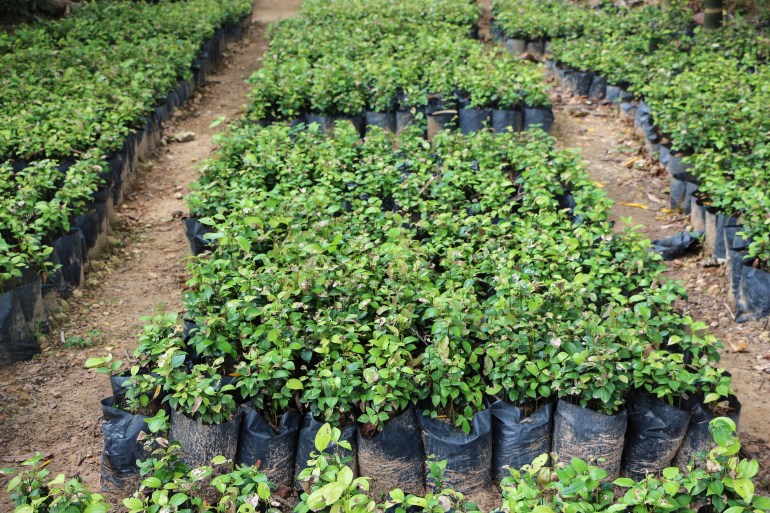
Cinnamon saplings grow for one year at the Carlton estate [Nathan Mahendra/Al Jazeera]
For harvesting, farmers cut down the branches of cinnamon trees at an angle, which allows cinnamon bushes to regrow, Lakshith says. Young and tender twigs are thrown away. Once branches are soaked in water and are moist enough, peelers remove the outermost layer of the cinnamon bark. To produce thin cinnamon quills, they spend hours stripping off the inner bark of the cinnamon branch in sheets.
Once produced, Ceylon cinnamon quills are graded based on their width; the thinner the quills, the higher they are in value. Alba is the highest form of cinnamon, with a diameter of 6mm. H1 is a lower grade of cinnamon, with a diameter of 22mm. In the export market, Alba costs twice as much as H1.
A generational craft
With a hearty smile, Suduhakuru Piyathilake holds a large batch of cinnamon quills. Piyathilake and his wife have been living in an old, dilapidated house next to the estate’s main building for 10 years now.
At 5am every day, Piyathilake heads off to the plantation. After collecting branches from about 15 trees, he plods back to the water tank in the main building, drops them off for soaking and returns to the plantation. He must make several trips back and forth before he begins peeling.
“When it’s moist, it’s easy to peel,” says the 55-year-old. “That’s why we cut them early in the morning and soak them.”
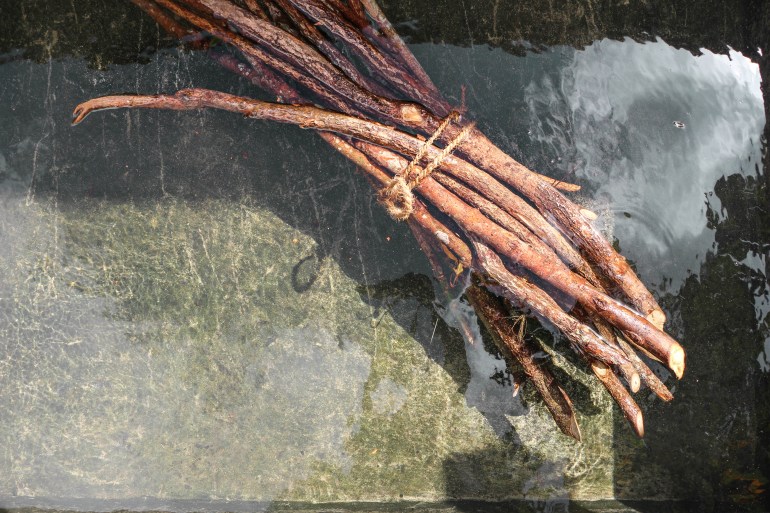
When the clock hits 10am, Piyathilake comes back with the last batch. After five hours, he has collected the branches of 200 trees. Sweat trickles down his forehead. A resident kitten swats at his feet, but Piyathilake ignores it and rushes in for a shower.
After a two-hour break, he sharpens his knife by scraping the outer bark of the branch and then he gets to work. “This is what my father and his father did,” he says. “Now my sons are cinnamon peelers.”
Piyathilake has been peeling cinnamon for the last 43 years. He learned the craft from his father in their village in Elpitiya, 70km north of the Runage family estate, where his children live with his mother. At home, cinnamon trees adorn their back yard, Piyathilake says. “But it’s a small garden so we can’t harvest cinnamon every day of the year. We don’t make much money there. So I work here with my wife. We only see our children once in every four months.”
Piyathilake is so adept at work that he can masterfully strip off extremely thin barks of the cinnamon branch by merely measuring them next to his index finger. After peeling the outer bark, he makes two cuts on two opposite sides before peeling off the inner bark. A half a length cut of your smallest bone is for Alba, Piyathilake says. For “rough” or H1 cinnamon quills, Piyathilake uses the length of two bones of his index finger.
However, even for experienced generational peelers like Piyathilake, making extremely thin Alba cinnamon is profitless. By 10pm – when he sets off to sleep – Piyathilake can have peeled about 5kg of lower grade cinnamon, earning about 2,500 rupees ($12.50) per kilogramme. “But I will only make just one kilo of Alba for the whole day,” he says. “Alba is smaller and lightweight so you need to make more quills to make up a kilo – that earns me only 4,300 rupees [$21.50].”
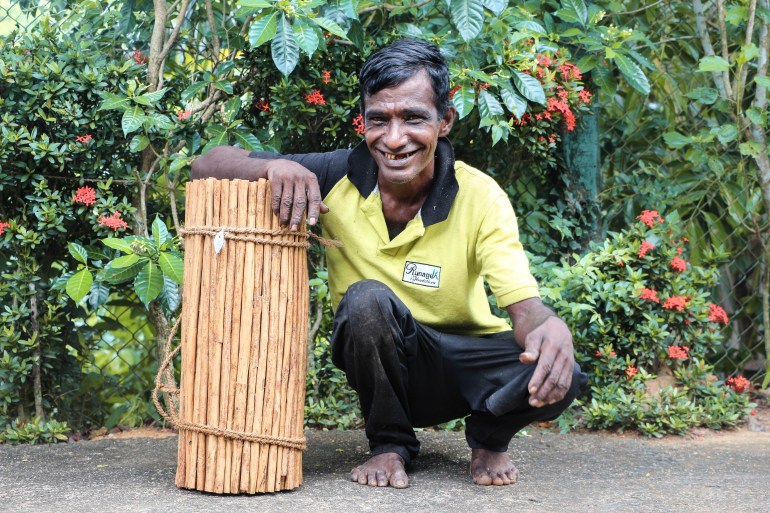
Suduhakuru Piyathilake, who has worked as a peeler for the last 43 years, is one of the last experienced peelers at the Carlton estate [Nathan Mahendra/Al Jazeera]
When Piyathilake removes the inner bark, it curls up within a few minutes under the shade. These barks are then stuffed with small cuttings of the bark called quillings to make one 42-inch (1 metre) quill. Quills are placed on ropes under the roof for drying. After three days, peelers pack them into bales and send them off to the factory.
For Piyathilake and his family, cinnamon is their bread and butter, but it is also much more than that. “It’s a craft you have to master for years. I started peeling cinnamon when I was 12. It took me several years to strip off thin layers of the inner bark without damaging it,” he says.
Skills shortage
For producers like Runage, however, it is not always easy to find skilled labour. At the Carlton estate, Piyathilake is one of their last experienced peelers. Runage feels that finding generational peelers is one of the biggest challenges in the business today.
“Peeling cinnamon requires hard labour, so the younger generations don’t want to do it any more. They prefer office jobs. It doesn’t necessarily mean that these office jobs will pay you more than peeling cinnamon, but an office job has a better social image today,” says Runage. “People consider peeling cinnamon as a low-level job, so it’s difficult for us to find experienced peelers now.”
Back at the estate’s main building, grey-haired Heenipellage Chandra sits on a floor mat, her eyes focused on the cinnamon bark she peels. For 10 years, the 62-year-old has walked to the estate daily to peel at least 3kg of cinnamon. Chandra recalls Runage’s father visiting her house in the late 1980s. “He came to meet my father-in-law and buy cinnamon from him.”

Heenipellage Chandra has been peeling cinnamon since the 1970s [Nathan Mahendra/Al Jazeera]
Chandra has been peeling cinnamon at home since she was married. “Somewhere in the late 1970s,” she says, trying to recall her wedding day, “Husband’s father and his father, all of them peeled cinnamon.”
But Chandra’s children do not peel cinnamon any more. Both her 20-something sons do office jobs, says Chandra as her eyes twinkle with a smile. She is proud of her sons. They have climbed the social ladder.
When the coronavirus pandemic began, most resident cinnamon peelers left for their homes during the months-long lockdowns. Runage had to shuffle his staff around to find labour; women from the factory were relocated to the estate to peel cinnamon.
Dayani Malkanthi, 44, worked at the packing department at the factory, but a few months ago when Sri Lanka went back into lockdown to battle a new wave of COVID, she came to the estate.
“I’m really slow. It’s a very hard job,” says Malkanthi, giving a faint smile while scraping the outer bark of a cinnamon branch. “I’m still learning.”

There are about 9,000 cinnamon farmers and peelers working with Rathna Producers Cinnamon Exports [Nathan Mahendra/Al Jazeera]
Once done, Malkanthi is careful to avoid any damage to the inner cinnamon bark. While experienced peelers like Piyathilake peel about 5kg a day, Malkanthi can produce only about 2kg. She is not happy here and wants to relocate to the factory. “Take us back to the factory,” she says to the visiting officer Lakshith.
“Let’s see. We are trying to find skilled peelers,” says Lakshith, walking past Malkanthi. He cannot make any promises. While the company struggles to find skilled labourers, coronavirus is another battle they have to tackle.
Of colonial oppression
Cinnamon was widely consumed as early as 3000 BC. The ancient world considered it a luxurious spice. For ancient Egyptians, cinnamon was a status symbol, which they also used in perfumes. The Greeks considered it a medicine. Sinhalese literature in the 10th century mentions that the island’s cinnamon was highly valued. In the 13th century, Sinhalese kings established economic ties with Egypt to export it. Historian Nirmal Ranjith Dewasiri says that from the beginning of the 10th century, Arab merchants traded Sri Lanka’s cinnamon to Europe along with other spices; the island became an important hub in the Indian Ocean trade.
In ancient Sri Lanka, the king was considered the guardian of the land. For cultivating the land, people had to perform a service to him. Historically, these tasks were assigned to certain castes. Cinnamon peeling was reserved for the Salagama community, who were originally weavers and believed to be the descendants of post-13th century South Indian migrants.
Cinnamon grew in the wild in Sri Lanka. Therefore, for months of the year, the head of the household would set off to the jungles to produce a certain amount of cinnamon for the king, in return for the land they cultivated.

“When the Portuguese colonisers came here [in the early 16th century], they took advantage of this ancient land tenure system,” says Dewasiri. A paper (PDF) by historian MU de Silva explains that a decree from Goa (then Portuguese India) declared the Salagama community to be descendants of captured slaves in order to exploit them.
Previously, cinnamon peeling was reserved for the head of the household in a Salagama family, but under Portuguese rule, boys as young as 12 had to peel cinnamon and deliver a certain amount of it. The colonisers increased this amount according to age and one’s physical condition. By the end of the 17th century, “the original weavers, now turned peelers, had to stay in the woods for more than eight months of the year”, writes MU de Silva.
Then in 1658, the Dutch (allied with the Kandyan kingdom in Sri Lanka) took control of Sri Lanka’s coastal belt after a series of battles with the Portuguese, and established a cinnamon monopoly by exploiting the Salagam community to supply the spice to meet the growing demand of the European market. Governor Rijckloff van Goens Jr, ruling from 1675 to 1680, referred to cinnamon as the “bride around whom all of us danced”. There were only a small number of peelers left in the coastal areas by then, Dewasiri explains. “Most people lost their lives because of battles against the colonial invasions and various diseases. Some of them had gone to the central hills of Sri Lanka to escape their fate,” says Dewasiri. “So there was more burden on the individual peeler.”
“When you marry a low-caste person, you automatically become part of that lower caste. So some Salagama people would marry into a lower caste to escape the burden on them,” says Dewasiri. “But the Dutch noticed that. So they made a new law. Even if you marry a low-caste person, you are still a cinnamon peeler. So there was no escape.”

Local headmen supervised the cinnamon peelers; they were paid by the Dutch according to the number of peelers they provided. According to MU de Silva, the Dutch forced “a person who could stand up and walk with the help of a stick” to peel cinnamon. Those who attempted to flee were “tied and tortured like high criminals to be placed in stocks and sent to Colombo for trial. And seldom they escaped flogging and other punishments in Colombo”, he adds.
When cinnamon trees dwindled in the jungles because of excessive peeling, the Dutch took measures to cultivate cinnamon. By 1794, there were 609 million cinnamon trees in southwest Sri Lanka. “By the end of the Dutch rule, there were massive commercial plantations of cinnamon along the coast. When the British occupied the island in 1815, other cash crops like coffee and tea became more important,” explains Dewasiri, referring to Dutch-era plantations like Cinnamon Gardens in Colombo. Today, there is hardly a cinnamon tree left in the area, which is now an upmarket neighbourhood with residential houses, boutiques and cafes.
A tourist experience
Despite these colonial-era changes, some generational labourers like Piyathilake are still peeling cinnamon. During their rule, Dutch colonisers also harnessed the services of other castes to meet their demands. One of those was the Hakuru caste, who were traditional jaggery makers. Piyathilake belongs to the Hakuru community in Elpitiya, a region famous for palm jaggery. But as far as his memory runs, his family never made jaggery.
“Cinnamon was the only thing we knew,” says Piyathilake, trying to recall the childhood stories he heard from his grandparents. “I don’t know how our ancestors began peeling cinnamon. Maybe we had so much cinnamon growing in the land.”
As for Runage, cinnamon is still tied to the lives of thousands of people in the south of Sri Lanka. In his company alone, there are about 9,000 registered farmers and peelers; more than 40,000 members of their families depend on the cinnamon industry for their income.
Cinnamon also occupies a place in the tourism industry today. Sarath de Silva, 70, lives on a small island named Ganduwa in Koggala Lake, roughly an hour’s drive and a 20-minute boat ride from the Runage family estate. Cinnamon trees grow in the wild here, and there are five houses in total.

Before the coronavirus pandemic, tourists swarmed Sarath de Silva’s house for an ‘authentic’ cinnamon peeling experience [Nathan Mahendra/Al Jazeera]
Before the coronavirus pandemic, many local and foreign tourists flocked to Ganduwa. De Silva peeled cinnamon as tourists snapped pictures; he then treated them to a cup of cinnamon-infused black tea. In return, most visitors would buy small packets of cinnamon quills, cinnamon powder and one-ounce (about 30ml) glass bottles of cinnamon oil. Each costs 400 rupees ($2).
For now, the pandemic has completely halted de Silva’s means of earning an income, but he is hopeful that tourists will return when the travel restrictions are relaxed.
De Silva is not the only one in the cinnamon tourism business. As foreign arrivals started increasing, more and more cinnamon growers organised tours for visitors. There were luxury tours like The Cinnamon Experience, where visitors can walk through a large estate and receive hands-on experience peeling cinnamon; tourists could also prepare and taste cinnamon-scented Sri Lankan curries.
The cassia challenge
While the Runage family has been successful in building a lucrative cinnamon business, their biggest challenge in the international trade has been cassia that masquerades as Ceylon cinnamon in the market.
“When you walk to Walmart or Costco in America, everything is labelled cinnamon. You can’t find what cassia is or what Ceylon cinnamon is,” explains Runage. “That’s a big challenge because cassia is cheap and people tend to buy it.”
Research shows that cassia also contains high levels of coumarin that may cause liver damage if one consumes it in large quantities. It is a reason why Ceylon cinnamon is also touted as the healthier option. But Runage says that most people are not aware of it. While European countries use cinnamon in their food, there is little demand from the continent for Ceylon cinnamon.

“European buyers like to buy products from the country of origin. That leads us to our next problem,” says Runage. ”To prove that Ceylon cinnamon comes from Sri Lanka, we need to acquire the GI [geographical indication] for Ceylon cinnamon.”
In 2020, Sri Lanka applied for the GI tag for Ceylon cinnamon. During the process, Madagascar objected. “The objection has been made by the Madagascar authorities on the grounds that ‘Ceylon cinnamon’ is not a variety, and they too grow Ceylon cinnamon,” JM Seneviratne, who is the Economics Research Unit director of Sri Lanka’s Department of Export Agriculture, told the local newspaper Sunday Morning.
“I didn’t take them to a lab to test, but I saw our cinnamon growing in Madagascar a couple of years ago when I went there,” says Runage. It is thought that sailors brought cinnamon to Madagascar around the 17th century. “They don’t use our traditional methods of peeling. So Ceylon cinnamon is very much our unique product. But unless we have the GI tag, we can’t go somewhere else and tout it as ours. No one will believe us.”
What the future holds
Runage believes that government intervention and a proper system to regulate the cinnamon industry is essential for the future. “No matter how much we make, businesses like us cannot fight for the GI tag. That’s up to the governments.”
For now, Runage exports most of the cinnamon produce to Latin American countries like Mexico, Guatemala and Peru. “We can get more buyers from South American countries, but they are quite far away. So if I travel there, I would want to visit a few countries at once,” explains Runage. “You would wonder why I can’t do that? Let me tell you. There’s an issue. If I want to visit Peru as a businessman, I have to go to the embassy in New Delhi to get a visa. Once I get it and apply for a visa to Guatemala, my Peru visa has already expired.” And this is where Runage needs government assistance – bilateral agreements between countries so businessmen like him can explore more opportunities.
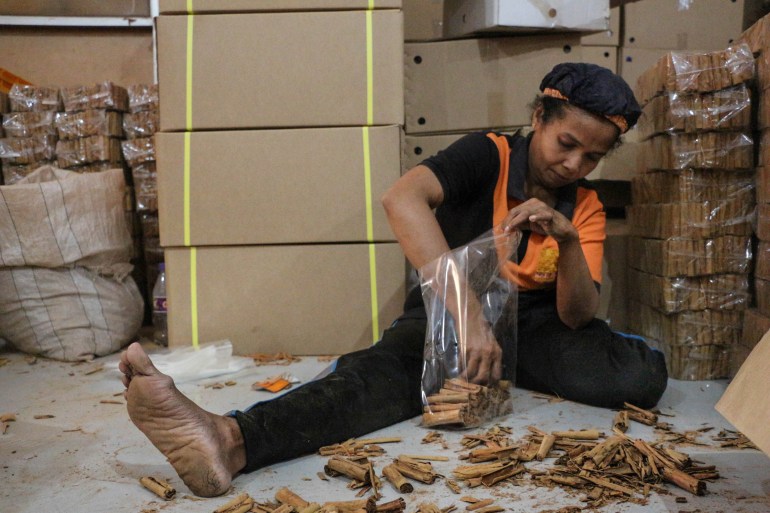
Nimali Wijenayake packs cinnamon at the Carlton estate packing department, where she has worked for last eight years [Nathan Mahendra/Al Jazeera]
Despite these challenges, the company continues to expand, exporting cinnamon quills and powder across the globe, and also producing and selling cinnamon oil – both leaf oil, which is used for perfumes, and bark oil, favoured by culinary experts. Currently, organic cinnamon accounts for only 1-3 percent of the company’s whole production, but Runage is hoping to expand soon.
Back in the estate, Piyathilake attends to his work peeling organically grown cinnamon and binding new quills for drying. There is a way to identify good cinnamon in the local market, he says. “If you see beautiful gold coloured cinnamon, never buy them. It looks beautiful, but it’s a lie. They are deceiving you. It’s sprayed with sulfur so they look pretty in the eye.”
Despite his long, tiring days at work, he is proud of being part of a generational craft that has put a roof over his family’s heads for centuries.
“You have to make these cinnamon quills look beautiful without any cuts or wounds,” he says smiling, “like the same way you would dress a new bride.”







